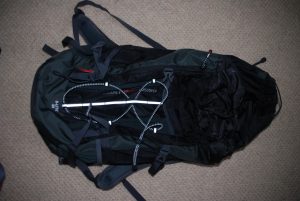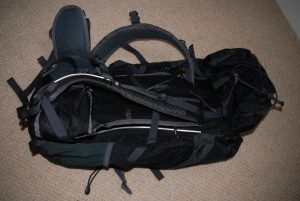Considering I will have to carry all my belongings in a pack on my back for the entirety of my hike, and for the Camino de Santiago that means for 780km, choosing the right backpack is another vital step in hike preparation.
Three main aspects when choosing a backpack
- Capacity: size depends on the length of the trip, your needs along the way and how much weight and bulk you’ll carry.
- Features: packs come with a range of different features, so it is worth considering which of these will best serve your needs.
- Fit: it is important to measure your torso length, not your height.
Volume of the backpack
While my hike is of considerable length, I actually don’t want to carry too much stuff. Having a larger backpack will just encourage me to squeeze more in when really, over the long haul, what will be most useful is paring everything right down to lightweight essentials. I won’t need to take a tent or a sleeping mat, nor will I need to carry all my food and water – and this cuts down considerably on the bulk and weight I would have to carry otherwise. So for the pack on MY back, I’m aiming for 35-45 litres. (That’s 2136-2746 in³).
Features of the backpack
There’s a range of amazing features, but I’ll list here the things I particularly think might be useful.
Hipbelt pockets: good for stowing small things you might want quickly – sunscreen, snacks, camera, etc.
- Padding: hip and lumbar padding to minimise sore spots.
- Attachment points: for things like trekking poles
- Rain cover: no doubt it will rain in my 33 days of hiking. But is a rain cover better than dry sacks? How do rain covers hold up in wind?
- Load lifter straps: these can help angle your pack and adjust the balance on your hips.
- Shoulder strap pockets: good for sunglasses, etc.
- Sternum strap: helps keep the pack steady.
- Water bottle pocket: because I don’t need to carry all my water, I won’t be carrying a water bladder – a water bottle pocket will, therefore, be useful.
- Compression straps: pull the contents of your back in toward the body for better balan

How the pack fits on my back
To measure yourself for a back bend your head forward and find that bone that sticks out the most on your upper spine.
Next, find the top of your hip bones, keeping your index fingers at the front of the body and your thumbs at the back.
Draw an imaginary line from that bone at the top of your spine to the middle of the line between your thumbs. Measure this line down your spine – or rather, have someone measure it for you.
This is your torso length.
REI Co-Op have a great page about fitting your backpack that includes a good diagram for measuring your torso. https://www.rei.com/learn/expert-advice/backpacks-adjusting-fit.html
I’ve learnt from my hunt for hiking boots that, in the end, it all comes down to feel. Yes, do the research and take note of the pros and cons of each brand, but ultimately, how they feel on you will be a HUGE deciding factor.
The same could be said for the pack on my back. Switchback Travel, http://www.switchbacktravel.com/best-backpacking-backpacks, and other sites, have a great comparison chart, but at the end of the day, go and try a few on and see how they feel.
See my blog: A Worded Life for more posts about my preparation and training.


